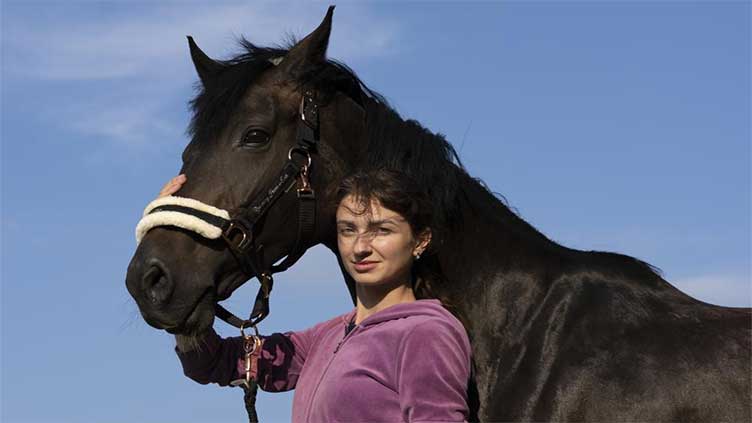Ukrainian woman's quest to retrieve body of prisoner of war

World
Ukrainian woman's quest to retrieve body of prisoner of war
CHUBYNSKE, Ukraine (AP) — In the last, brief conversations Viktoria Skliar had with her detained boyfriend, the Ukrainian prisoner of war was making tentative plans for life after his release in an upcoming exchange with Russia.
The next time Skliar saw Oleksii Kisilishin, he was dead — one of several bodies in a photo of people local authorities said were killed when blasts ripped through a prison in a part of Ukraine’s Donetsk region controlled by Moscow-backed separatists.
For months, Skliar had held out hope she would reunite with her partner, who had been one of the defenders of the Azovstal steel plant, the last redoubt of Ukrainian fighters in the besieged city of Mariupol.
Now, she has retrained her focus on getting his body back. Against enormous odds, Ukraine has now received the remains of dozens of prisoners who were held at the prison in Olenivka. But with experts still needing months to identify all the bodies — and no guarantee Kisilishin is among them — Skliar’s quest is far from over.
That she even knows her boyfriend is dead is remarkable. She recognized his tattoos in a photo shared on social media following the July 29 blasts. It showed him laid out, semi-naked, on the ground in a line with eight other bodies.
“When I saw the photo, my eyes did not go beyond Oleksii’s body,” Skliar told The Associated Press. “I didn’t have time to cry. I cried all my tears when they were in Azovstal. My first thought was to get the body back somehow.”
Skliar said she contacted representatives with the International Committee of the Red Cross, told them about the photo and gave them his name in the hopes that they’d be able to arrange for him to be brought home. The humanitarian organization couldn’t tell her much — the group had to wait for official lists of prisoners and agreements from politicians before it could help repatriate any bodies.
While she waited for word, Skliar feared her loved one would end up in a mass grave.
Kisilishin, who died at 26, was called back to the Azov Regiment, part of the Ukrainian National Guard, where he’d served until 2016, two weeks before Russia’s invasion of Ukraine in February. The animal caregiver and activist had chosen to return to defend his hometown of Mariupol, rather than stay in Kyiv, where he’d met Skliar at an equestrian club a year before.
When Kisilishin was holed up at the Azovstal steel mill during a three-month siege of the city, they spoke every day until Russian forces encircled the plant.
In May, he was captured when the last Azovstal defenders were told by Ukraine’s military to turn themselves over to Russian forces.
From captivity, Skliar continued to have phone calls from him, though they never lasted longer than a minute. Her boyfriend said little about himself, responding only “it’s OK” or “bearable” when she asked him how he was.
Then, Skliar said she received a call from Kisilishin — and his voice was cheerful. “He said that they will be taken somewhere. He hoped for an exchange,” she said.
She believes he was taken to Olenivka that day or soon after. Later, she said she heard from the Red Cross that he would be part of an upcoming prisoner exchange. But three weeks after that, he was dead.
Authorities at the prison and Russian officials have said 53 Ukrainian POWs died in the blasts and another 75 were wounded. On a list of the victims released by Moscow and published in Russian media, Kisilishin was number 43.
What exactly happened in Olenivka remains unknown.
Russia claims Ukraine’s military hit the prison with rockets. The Ukrainian military denied launching any strikes and accused Russia of mining it. Kyiv alleges that the Kremlin’s forces tortured prisoners held in Olenivka — and that the blasts were meant to cover up any evidence of those crimes.
The Office of the United Nations High Commissioner for Human Rights raised concerns recently about reports that prisoners in Olenivka and elsewhere were subjected to beatings, electrocution and other abuse.
The Russian Defense Ministry did not respond to a request for comment on Ukrainian allegations of what happened in Olenivka.
Russia and Ukraine agreed in August to a U.N. fact-finding mission, but U.N. deputy spokesman Farhan Haq said just over a week ago that the “appropriate security guarantees” were not in place for the work to start.
When other Ukrainian POWs returned in September, the photos showed emaciated but smiling faces. Skliar believes Kisilishin was supposed to be among them.
Instead, he probably returned to Ukraine in a bag labeled “Olenivka” — with 62 other bodies that were exchanged on Oct. 11. Relatives of soldiers have given DNA samples, and experts are now working to identify the remains, said the representative of the Patronage Service of the Azov Regiment, Natalia Bahrii.
It’s not clear why there were more than 60 bodies in the exchange, even though authorities put the death toll from the blasts at just over 50.
Kisilishin’s father, Oleksandr — who himself was captured as a POW and released — has given a sample.
To honor his son, the father, working with the NGO UAnimals, plans to arrange grants for animal shelters — continuing the work that Kisilishin devoted his life to.
The older Kisilishin and Skliar don’t talk much about their loved one. “We can’t have him back anyway,” Skliar recounted the father once said to her.
Still, Skliar hopes she will one day be able to bury him.
“He fought for the free people of a free country; he defended his city, Mariupol,” Viktoria said. “He is a warrior. And he has the right to be buried in the land he defended.”


